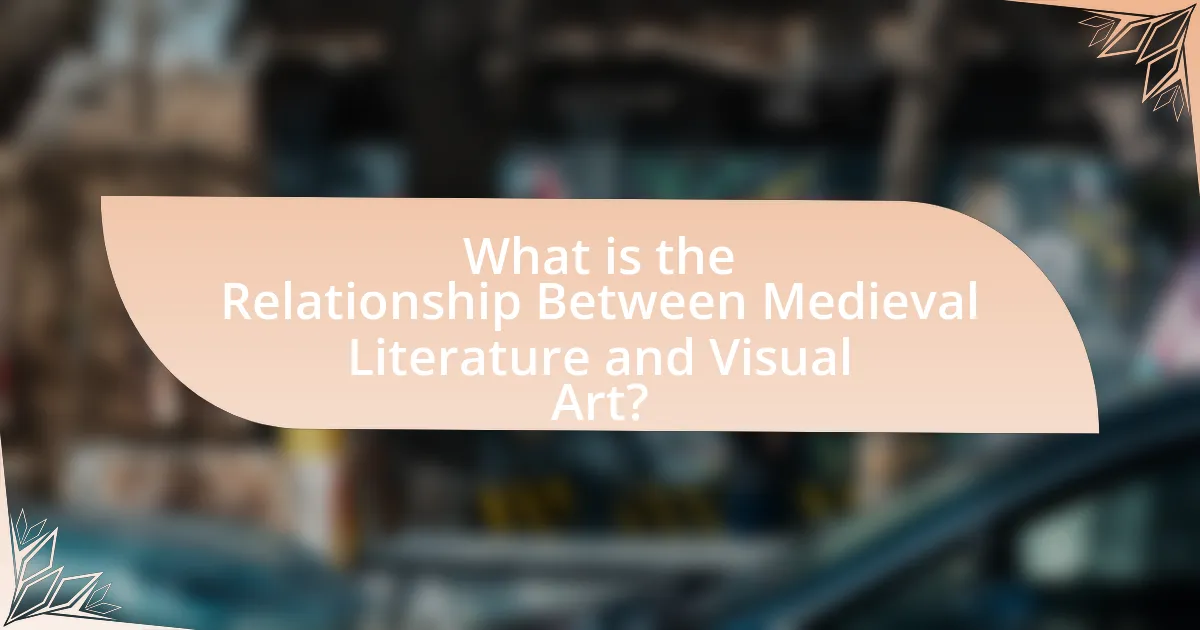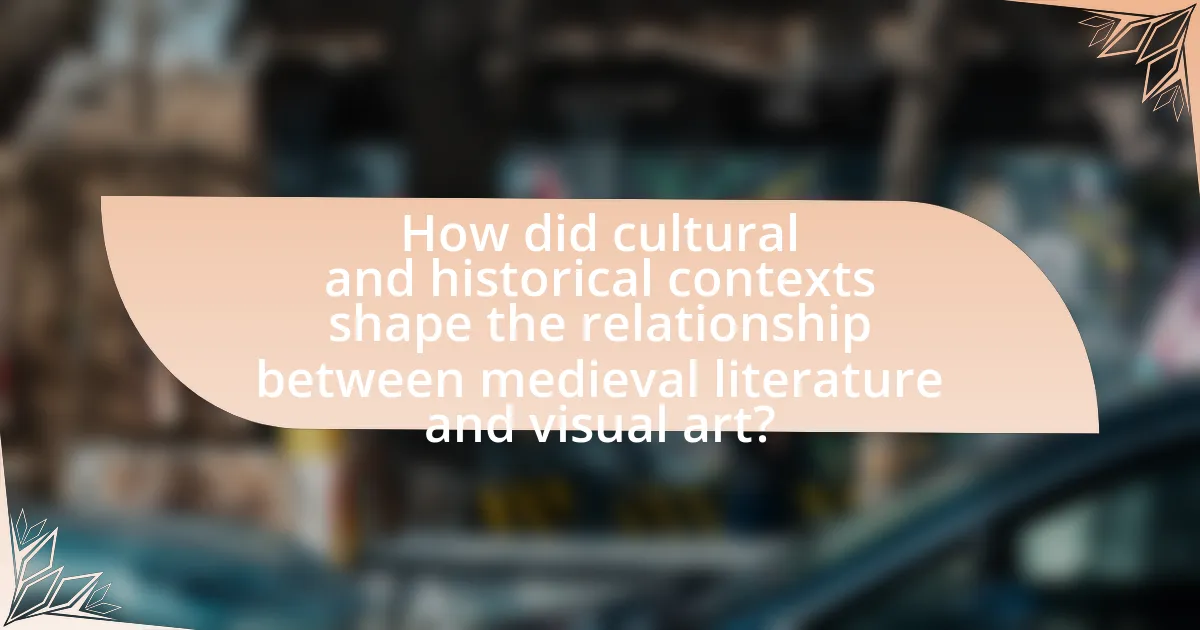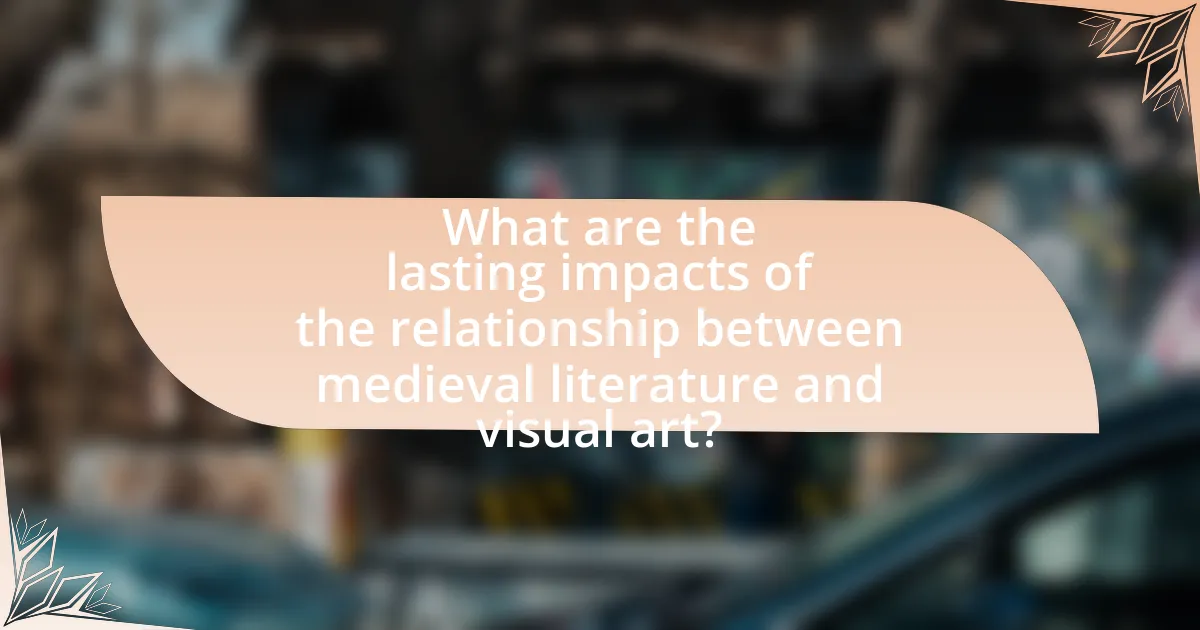The article examines the intricate relationship between medieval literature and visual art, highlighting their mutual influence and thematic connections. It discusses how literary works, such as Dante Alighieri’s “Divine Comedy” and Geoffrey Chaucer’s “The Canterbury Tales,” inspired visual representations in illuminated manuscripts and artworks, enriching the narrative experience. Key themes explored include chivalry, religious narratives, and courtly love, as well as the impact of cultural and historical contexts on both forms of expression. The article also addresses how advancements in artistic techniques influenced literary storytelling methods and the lasting effects of this relationship on modern literature and art.

What is the Relationship Between Medieval Literature and Visual Art?
The relationship between medieval literature and visual art is characterized by mutual influence and thematic overlap. Medieval literature often inspired visual representations, as seen in illuminated manuscripts where text and imagery coalesce to enhance storytelling. For example, the “Book of Hours,” a popular devotional text, featured intricate illustrations that depicted scenes from the Bible, thereby enriching the reader’s understanding and engagement with the narrative. Additionally, visual art served as a narrative tool, conveying moral and religious themes prevalent in literature, such as in the works of Dante Alighieri, whose “Divine Comedy” inspired numerous paintings and sculptures that visually interpreted its allegorical content. This interplay between literature and visual art during the medieval period illustrates how both forms of expression complemented each other, creating a richer cultural tapestry.
How did medieval literature influence visual art during the Middle Ages?
Medieval literature significantly influenced visual art during the Middle Ages by providing narrative content and themes that artists depicted in their works. Texts such as “The Divine Comedy” by Dante Alighieri and “The Canterbury Tales” by Geoffrey Chaucer inspired artists to create illustrations that captured the stories and moral lessons found within these literary works. For instance, illuminated manuscripts often featured scenes from these texts, blending literary and visual storytelling. Additionally, the allegorical and religious themes prevalent in medieval literature were reflected in the iconography of paintings and sculptures, as artists sought to convey complex ideas and narratives visually. This interplay between literature and art not only enriched the visual culture of the time but also helped to disseminate literary themes to a broader audience, reinforcing the interconnectedness of these two forms of expression during the Middle Ages.
What themes in medieval literature were commonly depicted in visual art?
Common themes in medieval literature that were depicted in visual art include chivalry, religious narratives, and courtly love. Chivalry, often illustrated through knightly quests and heroic deeds, is prominently featured in works like “The Song of Roland,” which inspired numerous tapestries and illuminated manuscripts. Religious narratives, such as the lives of saints and biblical stories, were central to both literature and art, as seen in the “Divine Comedy” by Dante, which influenced countless paintings and frescoes. Courtly love, a theme explored in works like “The Romance of the Rose,” was visually represented in art through scenes of knights and ladies, emphasizing ideals of love and devotion. These themes reflect the interconnectedness of medieval literature and visual art, showcasing how stories were translated into visual forms for broader cultural expression.
How did the narrative styles of medieval literature shape artistic representations?
The narrative styles of medieval literature significantly influenced artistic representations by providing thematic and structural frameworks that artists adopted in their visual works. For instance, the use of allegory and symbolism in texts like Dante’s “Divine Comedy” inspired artists to create complex imagery that conveyed moral and spiritual lessons. Additionally, the episodic nature of chivalric romances, such as those found in “Sir Gawain and the Green Knight,” led to the depiction of sequential scenes in illuminated manuscripts and tapestries, illustrating key moments in the narrative. This interplay between literature and visual art is evident in the way artists like Giotto incorporated narrative elements into frescoes, allowing viewers to engage with the stories visually, thus reinforcing the themes and messages present in the literature of the time.
What role did visual art play in the interpretation of medieval literature?
Visual art significantly enhanced the interpretation of medieval literature by providing visual context and symbolism that complemented textual narratives. Illuminated manuscripts, for example, often included illustrations that depicted scenes from the text, thereby aiding readers in understanding complex themes and characters. The use of iconography in art, such as the representation of virtues and vices, further enriched the moral and allegorical dimensions of literary works. Historical evidence shows that manuscripts like the “Book of Kells” and “The Luttrell Psalter” utilized intricate imagery to convey deeper meanings, making literature more accessible and engaging for audiences of the time.
How did illustrations enhance the understanding of literary texts?
Illustrations enhanced the understanding of literary texts by providing visual context that clarified and enriched the narrative. In medieval literature, illustrations served as a tool to depict complex themes, characters, and settings, making the text more accessible to readers who may have had varying levels of literacy. For example, illuminated manuscripts often included images that directly corresponded to the text, allowing readers to visualize scenes and comprehend the story more effectively. This visual representation not only aided in understanding but also engaged the audience, fostering a deeper emotional connection to the material. Historical evidence shows that manuscripts with illustrations were more popular and widely circulated, indicating their role in enhancing comprehension and appreciation of literary works during the medieval period.
What are some notable examples of illustrated manuscripts from the medieval period?
Notable examples of illustrated manuscripts from the medieval period include the Book of Kells, the Luttrell Psalter, and the Très Riches Heures du Duc de Berry. The Book of Kells, created around 800 AD, is renowned for its intricate illustrations and ornate lettering, showcasing the artistry of Celtic culture. The Luttrell Psalter, produced in the 14th century, features vivid imagery that reflects the daily life and social customs of the time, making it a significant historical document. The Très Riches Heures du Duc de Berry, completed in the early 15th century, is celebrated for its detailed miniatures and calendar illustrations, which provide insight into medieval life and the changing seasons. These manuscripts exemplify the rich interplay between literature and visual art during the medieval period.

How did cultural and historical contexts shape the relationship between medieval literature and visual art?
Cultural and historical contexts significantly shaped the relationship between medieval literature and visual art by influencing themes, styles, and the intended audience of both forms. During the medieval period, the Church played a central role in society, which led to a predominance of religious themes in both literature and visual art, as seen in works like Dante’s “Divine Comedy” and the illuminated manuscripts of the time. Additionally, the rise of vernacular languages allowed literature to reach broader audiences, paralleling the visual arts, which became more accessible through the use of frescoes and stained glass in cathedrals. The patronage system, where wealthy individuals and institutions commissioned works, further intertwined literature and art, as seen in the integration of poetic texts into visual narratives. Historical events, such as the Crusades and the Black Death, also influenced the content and emotional tone of both literature and art, reflecting societal concerns and aspirations.
What were the major cultural influences on medieval literature and visual art?
The major cultural influences on medieval literature and visual art were primarily religion, classical antiquity, and the socio-political context of the time. Religion, particularly Christianity, dominated both literature and art, as seen in the prevalence of biblical themes and moral lessons in texts and artworks. Classical antiquity influenced the revival of Greco-Roman themes and styles, evident in the use of mythological subjects and humanistic ideals. Additionally, the socio-political context, including the feudal system and the rise of universities, shaped the content and form of literary and artistic expressions, as reflected in the works of authors like Dante and artists like Giotto. These influences collectively defined the characteristics and evolution of medieval cultural outputs.
How did religion impact the themes in both literature and art?
Religion significantly influenced the themes in both literature and art during the medieval period by serving as a primary source of inspiration and moral guidance. In literature, religious texts such as the Bible shaped narratives, characters, and moral lessons, evident in works like Dante Alighieri’s “Divine Comedy,” which explores themes of sin, redemption, and the afterlife. Similarly, in art, religious themes dominated, with artists like Giotto and Michelangelo creating works that depicted biblical stories and figures, reinforcing the spiritual beliefs of the time. The prevalence of religious iconography in paintings and sculptures served to educate the largely illiterate population about Christian doctrine, demonstrating the integral role of religion in shaping cultural expressions in both fields.
What role did patronage play in the creation of literary and artistic works?
Patronage significantly influenced the creation of literary and artistic works by providing financial support and resources necessary for artists and writers to produce their creations. During the medieval period, patrons, often from the nobility or the church, commissioned works that aligned with their interests, values, and social status, thereby shaping the themes and styles of the art and literature produced. For instance, the commissioning of illuminated manuscripts by wealthy patrons not only ensured the survival of these texts but also dictated their visual presentation and narrative focus, reflecting the patron’s identity and aspirations. This relationship between patron and creator established a framework where the artistic output was often a direct response to the desires and expectations of the patron, thus intertwining the production of art and literature with the socio-political context of the time.
How did the evolution of artistic techniques affect literary expression?
The evolution of artistic techniques significantly influenced literary expression by enhancing the ways in which narratives were conveyed and experienced. As visual art progressed from flat, symbolic representations to more realistic and dynamic forms during the Renaissance, literature began to adopt similar techniques, incorporating vivid imagery and detailed descriptions that mirrored the advancements in painting and sculpture. For instance, the use of perspective in visual art encouraged writers to explore complex character perspectives and settings, leading to richer storytelling. This interplay is evident in works like Dante Alighieri’s “Divine Comedy,” where the intricate visual elements of the artwork complemented the narrative’s depth, illustrating the interconnectedness of visual and literary arts during that period.
What advancements in visual art techniques emerged during the medieval period?
During the medieval period, significant advancements in visual art techniques included the development of fresco painting, the use of tempera on wooden panels, and the introduction of Gothic architecture. Fresco painting allowed artists to create large-scale murals directly on wet plaster, enhancing the vibrancy and longevity of the artwork. The use of tempera, made from pigments mixed with egg yolk, enabled finer detail and brighter colors on wooden panels, which became a popular medium for altarpieces. Additionally, Gothic architecture introduced innovations such as pointed arches and ribbed vaults, which influenced the design of illuminated manuscripts and the overall aesthetic of visual art during this time. These techniques collectively transformed the visual landscape of the medieval period, reflecting the era’s cultural and religious themes.
How did these advancements influence literary storytelling methods?
Advancements in visual art during the medieval period significantly influenced literary storytelling methods by integrating visual elements that enhanced narrative depth and engagement. The incorporation of illuminated manuscripts, for example, allowed for a richer storytelling experience as illustrations complemented the text, providing context and emotional resonance. This synergy between text and image not only captivated readers but also facilitated a more immersive understanding of the narrative, as seen in works like the Book of Kells, where intricate designs and vibrant colors brought stories to life. Additionally, the use of visual symbolism in art informed literary themes and character development, allowing authors to convey complex ideas succinctly, thus transforming storytelling into a multi-sensory experience.

What are the lasting impacts of the relationship between medieval literature and visual art?
The lasting impacts of the relationship between medieval literature and visual art include the establishment of narrative techniques and thematic exploration that continue to influence contemporary storytelling and artistic expression. This relationship fostered a rich interplay where visual art illustrated literary themes, as seen in illuminated manuscripts, which combined text and imagery to enhance the narrative experience. For example, the Book of Kells, an illuminated manuscript from the 9th century, exemplifies how intricate illustrations complemented religious texts, thereby deepening the viewer’s understanding and engagement with the literature. Furthermore, the use of allegory in both literature and art during the medieval period laid the groundwork for future artistic movements, influencing Renaissance artists who drew upon these medieval themes to convey complex ideas and emotions.
How has the relationship influenced modern literature and art?
The relationship between medieval literature and visual art has significantly influenced modern literature and art by establishing foundational themes, narrative structures, and aesthetic principles. Medieval literature often incorporated allegorical and symbolic elements that have persisted in contemporary storytelling, allowing modern authors to explore complex moral and philosophical questions through similar devices. For instance, the use of imagery in works like Dante’s “Divine Comedy” has inspired modern visual artists to create pieces that reflect intricate narratives and emotional depth, as seen in the works of artists like Gustave Doré. Furthermore, the integration of text and image in medieval manuscripts has paved the way for modern graphic novels and illustrated literature, demonstrating a lasting impact on how stories are told across different mediums.
What contemporary works draw inspiration from medieval themes and styles?
Contemporary works that draw inspiration from medieval themes and styles include the television series “Game of Thrones,” which is based on George R.R. Martin’s “A Song of Ice and Fire” novels, and the video game series “Dark Souls,” known for its medieval aesthetics and lore. “Game of Thrones” incorporates feudal systems, chivalric codes, and elements of medieval warfare, reflecting the complexities of power and morality found in medieval literature. Similarly, “Dark Souls” features a dark fantasy setting with medieval architecture, knightly characters, and themes of honor and sacrifice, echoing the narrative structures and motifs prevalent in medieval texts. These works demonstrate a significant influence of medieval culture on contemporary storytelling and visual art.
How do modern interpretations of medieval literature reflect visual art influences?
Modern interpretations of medieval literature reflect visual art influences through the incorporation of vivid imagery and thematic elements that parallel artistic styles of the period. For instance, contemporary adaptations often emphasize the use of color, symbolism, and composition found in medieval paintings and manuscripts, which enhances the narrative experience. Research indicates that visual art from the medieval era, such as illuminated manuscripts, directly informs the descriptive language and character portrayals in modern retellings, creating a multi-sensory engagement that mirrors the original artistic intent. This connection is evident in works that draw upon the iconography and motifs prevalent in medieval art, thereby enriching the literary text with visual context and depth.
What can we learn from the study of medieval literature and visual art today?
The study of medieval literature and visual art today reveals insights into the cultural, social, and religious values of the time. Analyzing texts like “The Divine Comedy” by Dante and artworks such as the illuminated manuscripts demonstrates how these mediums reflect the beliefs and societal structures of medieval Europe. For instance, the use of allegory in literature parallels the symbolic imagery in art, illustrating the interconnectedness of narrative and visual representation. This relationship helps modern audiences understand the historical context and the evolution of artistic expression, as well as the ways in which these forms of creativity influenced one another.
How can understanding this relationship enhance our appreciation of both fields?
Understanding the relationship between medieval literature and visual art enhances our appreciation of both fields by revealing how they mutually influenced each other in conveying cultural narratives and themes. For instance, illuminated manuscripts, which combined text and intricate illustrations, exemplify how visual art enriched literary storytelling, making complex narratives more accessible and engaging. This interplay is evident in works like the “Book of Kells,” where the artistry of the illustrations complements the religious texts, deepening the viewer’s understanding of the spiritual context. By recognizing these connections, we gain insight into the historical significance and aesthetic values of the medieval period, fostering a greater appreciation for the creativity and innovation present in both literature and art.
What are some best practices for exploring the connections between literature and art in educational settings?
Best practices for exploring the connections between literature and art in educational settings include integrating interdisciplinary projects, utilizing visual aids, and encouraging critical discussions. Interdisciplinary projects allow students to create works that combine literary themes with artistic expression, fostering a deeper understanding of both mediums. Utilizing visual aids, such as illustrations from medieval manuscripts, enhances comprehension of literary texts by providing context and stimulating visual analysis. Encouraging critical discussions enables students to articulate their interpretations and explore the interplay between narrative and visual representation, which is essential in understanding the relationship between medieval literature and visual art. These methods are supported by educational research indicating that interdisciplinary approaches improve engagement and retention of knowledge.